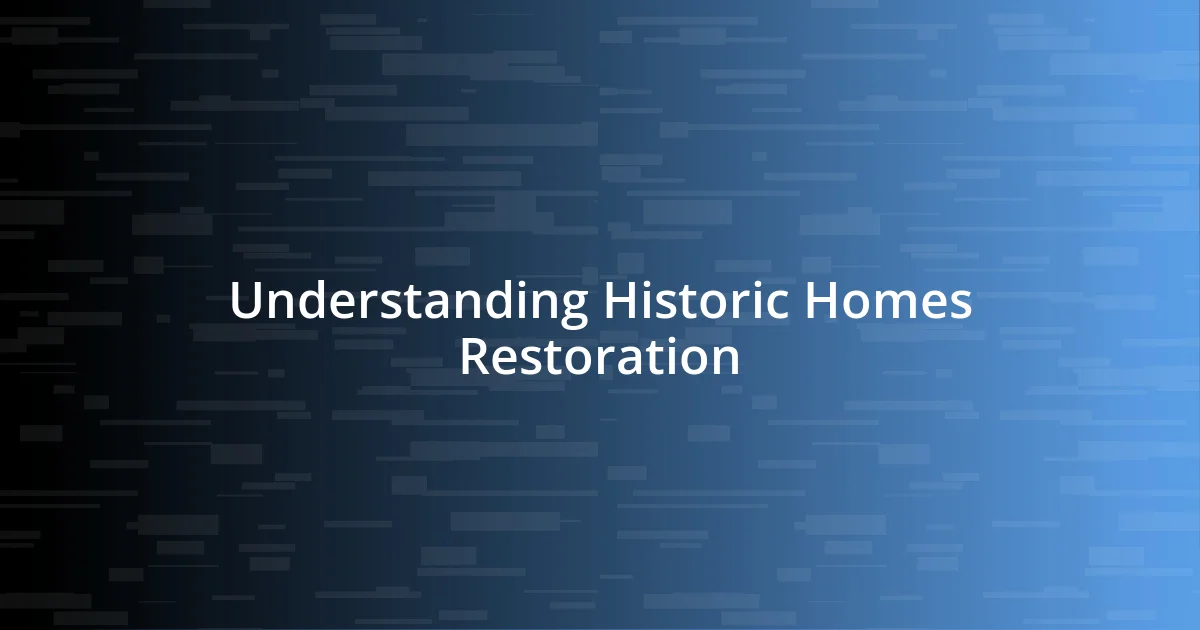Key takeaways:
- Conducting a comprehensive assessment and creating a detailed restoration plan are essential steps in the historic home restoration process, requiring careful prioritization and budgeting.
- Finding reliable restoration experts with a shared passion for preservation is crucial; open communication and chemistry can significantly enhance the collaboration.
- Choosing authentic materials and preserving historical features demand a balance between maintaining historical integrity and accommodating modern living needs, often requiring creative solutions and compromises.

Understanding Historic Homes Restoration
Restoring a historic home is like peeling back the layers of time. I still remember the day I uncovered the original moldings hidden beneath modern drywall. It was like stumbling upon a long-lost treasure that whispered stories of the past. Have you ever felt that thrill of connecting with history through a physical space?
Understanding the intricacies of historic restoration requires a blend of passion and patience. For instance, I was initially overwhelmed by the wide range of materials used in my home’s construction. Each wood species and architectural detail needed careful consideration to maintain authenticity. Isn’t it fascinating how every choice can affect the character and soul of the home?
I’ve learned that working with preservation guidelines is vital. These regulations not only protect the building’s integrity but can also guide your journey to restore it faithfully. I found myself often researching the history of my neighborhood to ensure that every element of the restoration aligned with the home’s authentic story. How much do you know about the historical significance of the buildings in your area?

Assessing the Condition of My Home
When I first stepped inside my vintage home, I was flooded with a mix of excitement and trepidation. The peeling wallpaper and creaky floors hinted at years of stories, but they also raised a slew of questions about what lay beneath. It became clear that conducting a comprehensive assessment was essential. I discovered early on that a meticulous inspection allowed me to unearth not just the visible flaws, but the hidden treasures as well.
Here’s a quick checklist I used to assess the condition:
- Structural Integrity: Check for cracks in the foundation or walls.
- Roof Condition: Look for missing shingles and signs of leaks.
- Windows and Doors: Test for drafts and inspect for mold or rot.
- Plumbing and Electrical Systems: Inspect for outdated or faulty wiring and pipes.
- Historical Features: Identify original elements like molding or staircases that need restoration.
As I documented these findings, I felt a stronger connection to my house, each note echoing its history. The process became less about fixing up a structure and more about preserving a piece of my community’s heritage. In those moments, I found joy in understanding how every assessment brought me one step closer to breathing life back into this cherished home.

Creating a Restoration Plan
Creating a restoration plan for a vintage home is a crucial step in the restoration process. I remember sitting down with a giant roll of graph paper, sketching out my vision and goals. It felt overwhelming at first—where to even start? The key was to break it down into manageable phases. For instance, I prioritized urgent repairs, like the roof, before moving on to cosmetic details like paint colors. By establishing clear priorities, I maintained focus and avoided feeling lost in the vast ocean of possibilities.
Budgeting was another crucial element of my plan. I thought I had a good grasp on costs, but as I delved deeper, unexpected expenses popped up. I learned to set aside a contingency fund to handle surprises. During my restoration, I found that sourcing materials locally not only supported my community but also added character to my project, creating a deeper connection to the place I was revitalizing. Have you ever had to juggle costs while pursuing your passion?
Lastly, I realized the importance of timelines. For me, creating a realistic schedule was essential in managing the process without feeling rushed. I marked the major milestones, like completing structural repairs or restoring key architectural features. It was a journey, and as dates approached, I celebrated each completed phase—bringing me one step closer to living in the home of my dreams. Remember, flexibility is vital; sometimes, genuine connection and preservation take time.
| Step | Consideration |
|---|---|
| Prioritizing Repairs | Focus on urgent issues first, like structural integrity |
| Budget Planning | Include a contingency fund for unexpected costs |
| Timeline Management | Set realistic milestones to track progress |

Finding Reliable Restoration Experts
Finding reliable restoration experts can feel daunting, but it’s a vital step in your journey. I learned that conducting thorough research is key. Start by exploring online reviews and asking for recommendations within historic preservation forums. When I found potential experts, I didn’t hesitate to reach out for initial consultations. It’s surprising how much a simple conversation can reveal about their expertise and passion for preservation.
After narrowing down my options, I made it a point to ask for references and examples of previous work. One expert showed me photos of a stunning restoration of a Victorian home that resembled mine, and I knew I could trust their vision. Trust me, seeing past projects gave me insight into their craftsmanship and attention to detail. Additionally, communicating openly about my goals helped ensure we were on the same page. Have you ever felt the relief of finding someone who truly understands your vision? It can make all the difference.
Finally, I discovered that chemistry matters too. When I met with my restorers, I focused on feeling comfortable discussing my ideas and concerns. The best experts aren’t just skilled; they’re also approachable and understanding. I remember one candid conversation where we tackled the exact shade of blue I envisioned for the shutters. That back-and-forth made me realize I had found the right team to partner with on this emotional adventure. In restoring a historic home, having a reliable expert who shares your passion is invaluable.

Choosing Authentic Materials
Choosing authentic materials was one of the most rewarding yet challenging parts of my restoration journey. I recall stumbling upon an old barn nearby that was slated for demolition. It felt like fate when I discovered authentic weathered wood that perfectly matched the original beams in my home. That moment taught me how essential it is to source materials that encapsulate the history and character of the house instead of opting for modern substitutes. Have you ever come across a find that connected you to a place’s past?
I quickly learned that using genuine materials involved more than just aesthetics; it was about craftsmanship and longevity. For example, I encountered a local artisan who crafted handmade bricks in a way that mirrored the original manufacturing technique from when my house was built. Seeing the process firsthand made me appreciate the dedication that goes into creating materials that not only look right but truly belong. Isn’t it fascinating how the stories behind materials can add an entirely new layer to your home?
While I loved the idea of authenticity, balancing it with practicality was crucial. In some areas, I had to compromise on materials based on availability or budget constraints. I remember a tough moment debating between original tile and a beautiful replica that felt just right. In the end, I chose the replica—it was a reminder that while authenticity is invaluable, sometimes the best decisions involve blending the old with the new to create a comfortable and livable space. How have you navigated the balance between staying true to history and making your home your own?

Navigating Permits and Regulations
I quickly realized that navigating permits and regulations was almost like a rite of passage for anyone restoring a vintage home. I remember feeling overwhelmed by the amount of paperwork involved. From local zoning laws to historic preservation guidelines, each step felt like a labyrinth. Did you know that what you plan to restore can influence the permits you need? For instance, I discovered that changing windows in a historic district often demands additional documentation if you’re aiming for authenticity.
When I started my journey, I thought the process would be straightforward, but I soon learned the importance of patience. I often found myself in meetings with city officials, discussing my plans and intentions. It was a bit intimidating at first, but I found that being honest about your vision can make a significant difference. I recall one particular meeting where I shared my passion for maintaining the original character of my home. The officials responded positively, which made navigating the regulations feel less like an obstacle and more of a collaboration.
Connecting with other homeowners and restoration enthusiasts about their experiences was invaluable, too. I learned tips and tricks that turned daunting tasks into manageable ones. One friend even shared a crucial moment when she found a loop hole that allowed her to skip a particular permit. It made me wonder—what other hidden gems are there in the regulations? By forming a community, I not only eased my journey but also unearthed strategies I wouldn’t have thought of on my own. It reminded me that while the process can be cumbersome, finding support can turn ash into beauty.

Preserving Historical Features
I found that preserving historical features demanded not just attention but also a deep respect for the craftsmanship of the time. During one restoration phase, I stumbled across ornate moldings hidden under layers of paint. The moment I uncovered their intricate designs was exhilarating! They felt like whispers from the past, and I knew I had to restore them to their former glory. Have you ever uncovered something in your home that made you feel like you were touching history?
However, restoring historical features often meant facing unexpected obstacles. I vividly remember the day I tried to match the old plaster on my living room wall. It felt an almost herculean challenge, but my determination pushed me forward. I sought out artisans who specialized in historical restoration techniques. Seeing them work was like watching artists at play; their methods were both an homage to the past and a practical solution for the future. Isn’t it remarkable how skilled hands can breathe life back into forgotten details?
At times, I grappled with the dilemma of showcasing historical features versus modern living needs. For instance, my kitchen had beautiful antique cabinetry that I cherished but also needed updating for functionality. After much reflection, I decided to preserve the cabinet frames while integrating modern amenities behind them. This fusion allowed me to maintain the charm of the past while embracing the conveniences of today. Have you found ways to merge different eras in your home? It’s a continuous dance between honoring history and ensuring a comfortable, functional living space.














